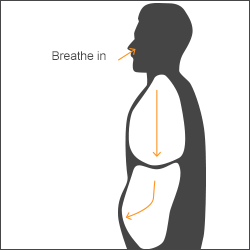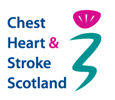Relief of breathlessness: breathing techniques

Breathing exercises can be taught by a physiotherapist to help the patient to breathe more comfortably and efficiently, control panic and recover breath more easily. They should be practised when the patient is not feeling short of breath so that they can be used more confidently when needed.
Pursed Lip Breathing
When exercising or recovering from an attack of breathlessness some people find it helpful to breathe out through pursed lips. The purpose of pursed lip breathing is to create back-pressure inside airways to open them so that moving air in and out takes less effort.
- Breathe in through your nose if possible (use mouth if very breathless).
- Exhale through pursed lips as if blowing out a candle or blowing on hot food (“smell the rose then blow out the candle”).
- The exhaled breath should be longer than the inhaled breath. For example inhale for one second and exhale for two seconds.
- To begin with you may need to wait for the breathing to slow down, (see relaxation and distraction) or perhaps count the breaths. Every 10th breath out blow out a little more through pursed lips, then every 5th breath out, then every 2nd , then every breath out as you feel able.
Breathing Control
Relaxed breathing with minimum effort. It is sometimes called diaphragmatic or belly breathing. Note that some patients with advanced lung disease need to use their upper chest muscles too during quiet breathing. Aim to return to this style of breathing as breathing slows down.
- Place one hand on the upper chest over the sternum or breast bone and the other gently on the stomach. Feel the slight movements of each hand. The hand on the chest should have little movement but the hand on the stomach should rise and fall with each breath in and out.
- Some patients find this easier to do if they close their eyes to help focus on their breathing.
- Relax the shoulders and neck muscles and try not to hold the stomach in.
- Breathe out gently, through your nose if possible. Let your shoulders and upper chest drop and your hands and arms feel loose or heavy as you breathe out. Make your breath out twice as long as your breath in.
- Breathe in smoothly through your nose. Feel your tummy rise a little as you breathe in and let it go as you breathe out.
- Aim to breathe in and out in a smooth, steady rhythm. Don’t hold your breath.
- Distraction can help to calm and regulate the breathing. Try counting “in, 2, out 2,3,4 etc “ or "Square Breathing” : Look at a square picture, window or screen. Focus on the corner as you breathe in, then breathe out as your eye moves along the square to the next corner.
Blow as you go
This can help to keep the breathing smooth and easier when exercising and performing daily tasks.
- Avoid breath holding.
- Exhale during the difficult part of an activity e.g. blow out as you bend down to put on a shoe, move from sitting into standing, reach up high or lift something heavy.




